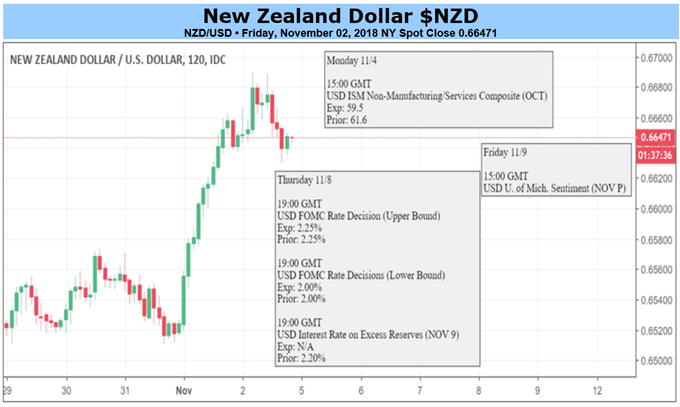
New Zealand Dollar Fundamental Forecast: Neutral
- Reduction in US China trade war concerns resulted in aggressive New Zealand Dollar gains
- RBNZ may disappoint monetary policy bets on third quarter CPI data, sending NZD falling
- US midterms, with Fed rate hikes still in sight, offer level of uncertainty for sentiment and NZD
We just released our 4Q forecast for equities, which may impact NZD, in the DailyFX Trading Guides page
The pro-risk New Zealand Dollar was on pace last week to mark its best performance against the US Dollar in almost two months. After a shaky October for global stock markets, November began on an upbeat as the S&P 500 set itself up for the most upside progress over the course of one week since March. The backdrop for this optimism seemed to be a cooldown in US China trade war concerns which was further bolstered Friday.
This coming week holds a level of uncertainty for NZD prices given multiple critical event risks. Starting with domestic concerns, the New Zealand Dollar awaits both a jobs report and an RBNZ rate decision. The former is due to cross the wires first and may even surprise to the upside. Such has been the case for New Zealand economic data as of late, suggesting economists are underpricing the health and vigor of the economy.
However, overnight index swaps are not pricing in one rate hike from the RBNZ in 2019, suggesting that New Zealand’s jobs report may have limited implications for NZD. Such was also the same scenario for third quarter CPI data which crossed the wires better-than-expected, reducing what was dovish monetary policy bets at the time. That led to a dramatic appreciation in the Kiwi Dollar however, and it may repeat itself.
Since then, the central bank has been relatively quiet and has given no clear signs that the stronger third quarter inflation report might tilt their forward guidance into favoring a rate hike. At the moment, policymakers have left the door open to a cut. Should the status quo remain the case, we may see a selloff in the New Zealand Dollar as bets on the CPI data (and possibly jobs too) unwind and vice versa.
For broader risk trends, the question remains whether or not market mood can continue improving as the Fed is on pace to keep raising interest rates. In the bigger picture, that seems fanciful. But for now sentiment, and thus the New Zealand Dollar, await the outcome of the US 2018 midterms. Polls are anticipating for Democrats to gain control of the House of Representatives while Republicans maintain a narrow majority in the Senate.
As such, the markets are probably pricing that in and an outcome in line with expectations may not do much to surprise traders. Thus the unexpected outcome would be Republicans holding both houses or Democrats gaining control of them. The former allows for US President Donald Trump to pursue his trade agenda without much interruption and vice versa. Given these uncertainties, the NZD outlook will have to be neutral.
Just getting started trading currencies? See our beginners’ guide for FX traders to learn how you can apply this in your strategy!
--- Written by Daniel Dubrovsky, Junior Currency Analyst for DailyFX.com
To contact Daniel, use the comments section below or @ddubrovskyFX onTwitter





